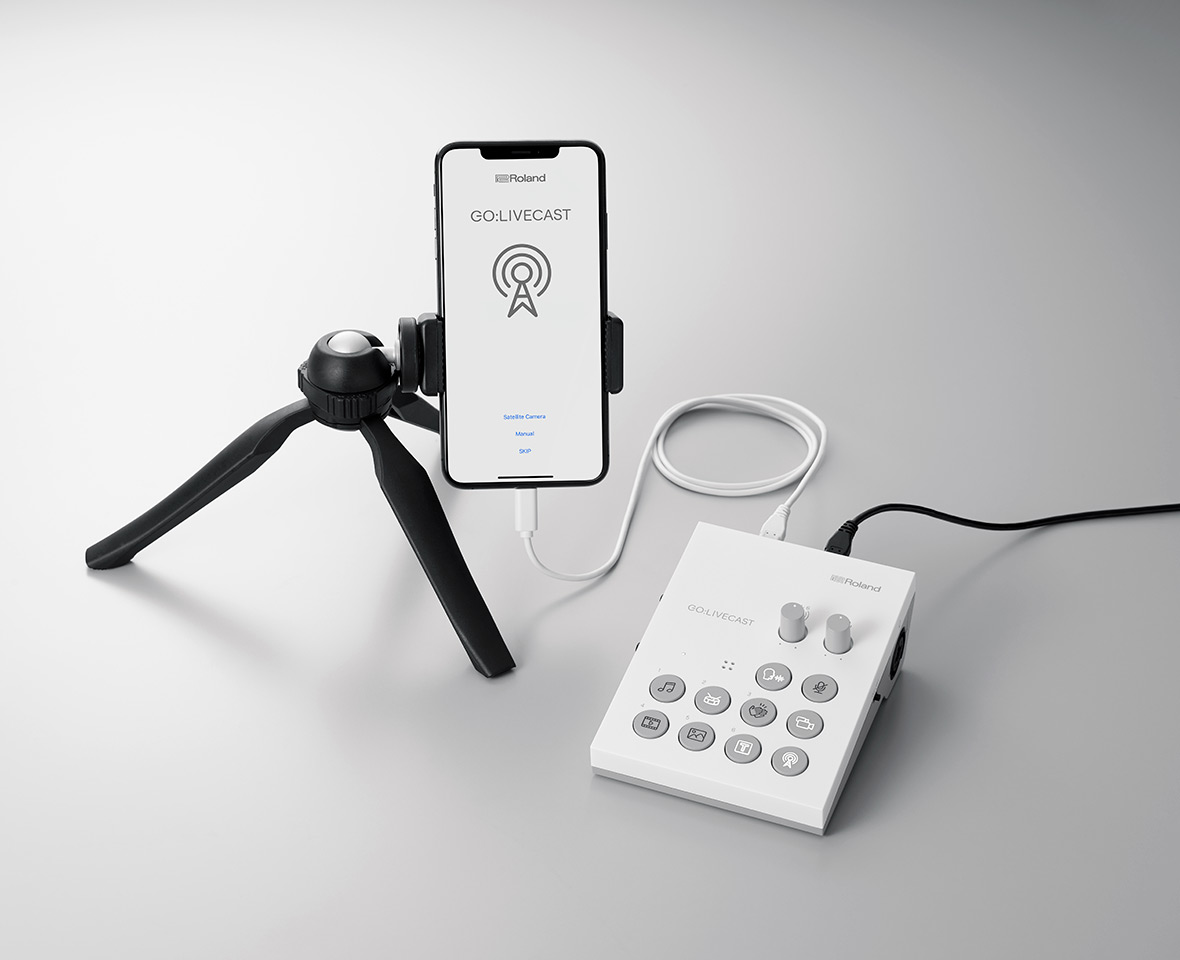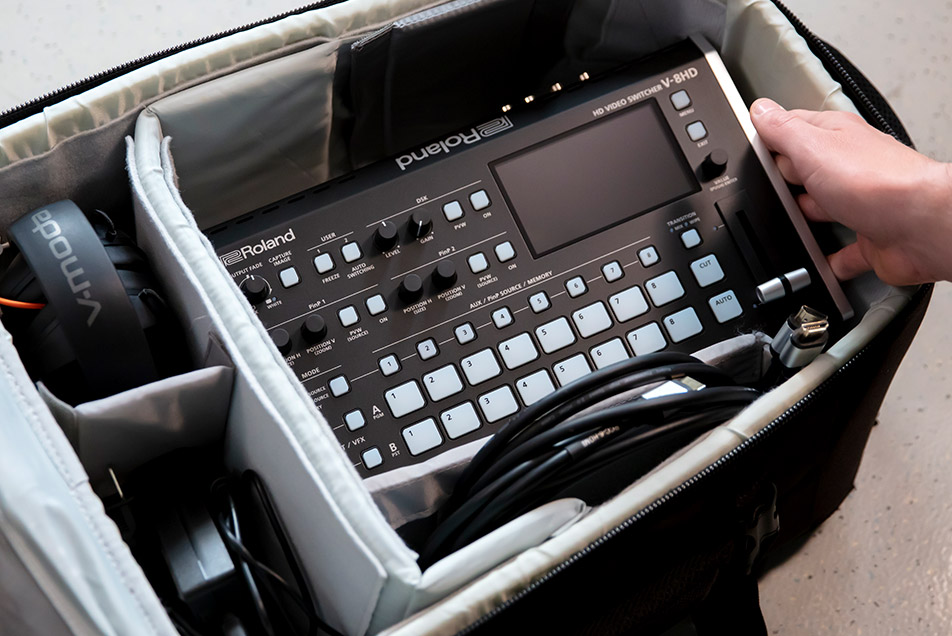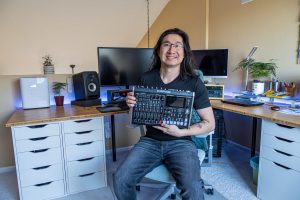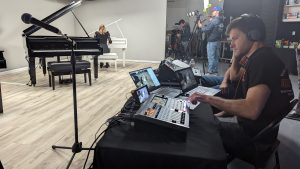- Choosing the right camera is essential to the livestreaming process.
- Smartphone cameras continue to improve in dynamic range, color saturation, and clarity with each new model.
- Multi-camera setups can help diversify content.
- DSLRs, PTZs, switchers, and other gear offer professional solutions.
Whether you’re devising a livestreaming setup for a house of worship, YouTube program, or any other scenario, the camera is the key to finding success. When deciding which type of camera will best suit your needs, there are different types to consider. Choosing the ideal platform, whether Facebook Live, YouTube, TikTok, or Twitch, will also provide guidance. Whether your setup will center around multiple pro cameras or be less elaborate, there are many options for a quality system.
Choices, Choices, Choices
One easy camera choice to use in a livestreaming system is a smartphone like a Samsung, Google, or iPhone. When looking at the feature sets for livestreaming, begin by comparing resolutions. The iPhone and Samsung boast recent models with 12-megapixel cameras. Other manufacturers’ phones can shoot up to 48MP.
Phone Cameras Continue to Improve
In recent years, the major phone manufacturers have made great strides. These phones continue to improve in dynamic range, color saturation, and clarity with each new model. However, beyond what a smartphone and its camera can do when livestreaming, what gear does one need for a quality production?
Plugging into a massive audio mixing console isn’t particularly ideal when filming on the go. No worries. When you need to mix sound, trigger sound effects, or play media, the Roland GO:LIVECAST can capably step in. With its small footprint of 4 1/5 inches (width), 5 2/5 inches (depth), and 2 inches (height), this unit can handle an impressive workload.
The GO:LIVECAST features connections including XLR or USB Micro-B, with mic. If one wishes to plug in a guitar preamp or synthesizer, the GO:LIVECAST also includes a stereo line input. Plus, a simple touch can begin a broadcast or launch photos and videos to feature in a presentation.
One easy camera choice to use in a livestreaming system is a smartphone like a Samsung, Google, or iPhone.

Think Beyond One Angle
For portability, graduating from a single smartphone could be beneficial or necessary. To that end, being flexible with multi-camera setups, whether outside or in a studio, will help diversify your content. Having each of your smartphone cameras run wirelessly adds simplicity to a setup. Otherwise, things can get messy when running multiple cameras in a sea of wires.
Smartphones—a Smart Choice
Let’s say you’re opting to run two to four smartphones for filming. Look to purchase a mix of flexible universal smartphone stands and traditional tripods paired with phone mounts. With each of the phones positioned correctly, capturing various angles will become manageable.
Another major benefit of opting to use multiple smartphone cameras is saving time. Think of the hours spent moving one smartphone around, while multiple cameras could achieve the same result. After repeatedly moving a single camera for a shoot, it won’t take long to imagine the difference this could make.
Having each of your smartphone cameras run wirelessly adds simplicity to a setup.
Benefits of a Multi-camera Setup
Using a multiple-camera setup isn’t limited to additional angles, but different depths of what is being captured. A worthwhile balancing act is to flip between closeups of your subject and views incorporating a larger field of vision. Managing multiple smartphone cameras doesn’t require a large video switcher that is anything but portable. With the right tools, you don’t have to lower your expectations in terms of production quality either.
Among the best solutions is the Roland AeroCaster. With this A/V switcher, its manageable size makes mobile shoots a snap. AeroCaster’s wireless capabilities support switching up to four devices when paired with the system iPad’s camera. The AeroCaster’s connectivity extends beyond wireless too. It features wired XLR inputs and a 3.5-mm stereo input, as well as headphones and monitor outputs.

Beyond the Smartphone
Even with a smartphone’s portability advantages, a DSLR from Canon, Nikon, or Sony, among others, offers greater versatility. Among the benefits of such cameras is attaching various lenses, including a telephoto lens.
Even with all the strides smartphones have made, their camera lenses remain small by comparison. For example, the latest iPhone comes with a 26mm-equivalent lens. With a DSLR camera, users can choose a wide variety of attachable lenses. For example, one can attach a wide-angle lens that can offer a focal length of 35mm. From there, one can smoothly switch to a 300-plus mm super-telephoto lens, with various other lenses in between.
A worthwhile balancing act is to flip between closeups of your subject and views incorporating a larger field of vision.
DSLR Advantages
In addition, a DSLR offers greater control of aperture, shutter speed, and ISO settings. All this can make the right DSLR camera a savvy choice for some livestreamers. This is especially the case in low-light settings, such as a worship service or musical event. In large part, that’s due to a DSLR’s much larger sensors. DSLRs tend to translate the minimal light, thereby creating a better overall image.
Switch it Up with a Switcher
Working with a more capable camera, one might also opt for a more feature-rich audio and video mixer. That’s where a piece like the Roland V-8HD Video Switcher comes in.
Switchers like the V-8HD have a small footprint and offer easy movement between locations. The V-8HD has significant features and connectivity, with eight HDMI inputs and a built-in 18-channel audio mixer. From there, choose to connect to the V-8HD a smartphone, DSLR, camcorder, or tablet. In addition, the unit has built-in scalers on two of its HDMI inputs. Pairing a DSLR with the V-8HD creates a pro combination, capable of high-quality audio and video compositions.

Switchers like the V-8HD have a small footprint and offers easy movement between locations. The V-8HD has significant features and connectivity, with eight HDMI inputs and a built-in 18-channel audio mixer.
Controlling Video Gear with an Installed Mixer
If a setup requires even more production capability, a multi-format video mixer can be a strong match. This is especially the case when using PTZs (pan-tilt-zoom) or professional video cameras.
As previously detailed, video switchers and their associated gear come in many shapes, sizes, and prices. There are benefits that come with portability for some desired setups. For a configuration with professional cameras and a multi-format mixer, the priorities tend to differ from the basics.
PTZs
Still, manned cameras aren’t always necessary—even when multiple angles require coverage. For instance, if your space lacks the crew to place someone behind each camera, PTZs are a great option. Such cameras provide plenty of control, all handled by a single operator.
Perhaps you are using manned cameras set to capture 4K, or plan on a mix of professional cameras with PTZs. If so, a combination broadcast switcher and live event switcher can excel in such a setting.
For more production capability, a multi-format video mixer can be a strong match. This is especially the case when using PTZs or professional video cameras.
Professional Solutions
Managing professional-level gear? A Roland V-1200HD multi-format video switcher and V-1200HDR control surface do this with ease. With its hybrid engine, the V-1200HD offers control of a wide range of video sources, key layers, and mixing engine configurations. Such a combination can well achieve meeting the high-quality production needs of a studio or live production. In a setup short on live camera operators, the V-1200HD system can control up to seven remote cameras.
There are numerous demands on video production today, even when using a single smartphone. With that in mind, integrating various shots and angles improves the livestreaming experience for the viewer. Maximizing that experience with even the most basic livestreaming gear will help upgrade your overall production.




